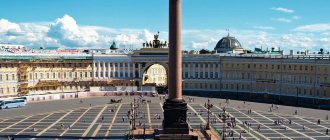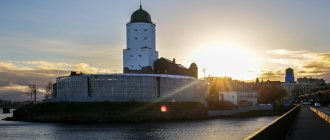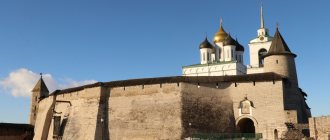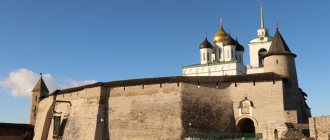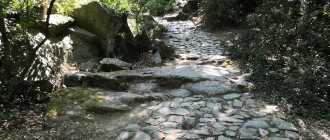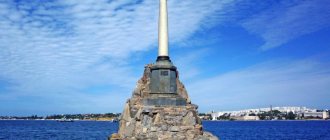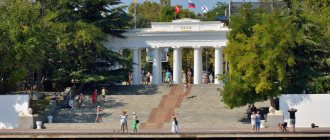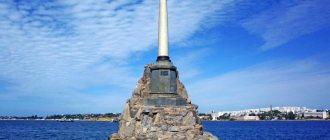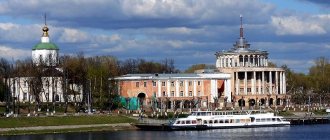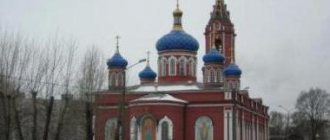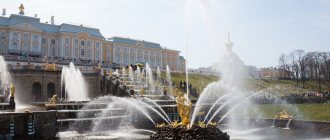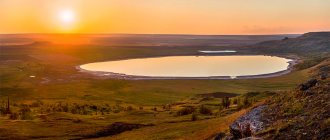If you decide to spend your next vacation studying the culture of other peoples of our country, we advise you to pay attention to the cities of the Republic of Khakassia. Even in Soviet times, this region was considered a center of tourism; people went here for new experiences in terms of studying ethnic values and to admire the picturesque corners of wild nature. The small region is full of ponds, steppes and impenetrable forests, so here you can spend a quiet family holiday on the shores of a salt lake or go on a real journey through the wilderness. However, you should start any trip from large settlements in order to plan your route, get acquainted with cultural values and stock up on provisions. Here are a few cities you should visit first.
What holiday is it today?
February 10, 2022, Thursday
Today are holidays, events: Diplomat's Day Tomorrow: World Sick Day Discovery of insulin
Today is the Orthodox holiday: St. Ephraim the Syrian. Venerable Ephraim of Novotorzhsky. Venerable Ephraim of Pechersk, Bishop of Pereyaslavl. Venerable Theodosius of Totem, Spasosumorin of the monastery, leader and founder... Tomorrow: Transfer of the relics of the holy martyr Ignatius the God-Bearer. Saints Gerasim, Pitirim, Jonah, bishops of Great Perm, Ustva...
Today is a national holiday: Ephraim's Day... Tomorrow: Lawrence's Day
Seasons
Seasons, four periods of the year (spring, summer, autumn and winter) characterized by certain average temperatures. The period during which the Sun passes through one of these sectors is called the season. Spring in the Northern Hemisphere and autumn in the Southern Hemisphere begin when the Sun passes through the initial circle of declination and its right ascension is 0° (vernal equinox). Summer in the Northern Hemisphere and winter in the Southern Hemisphere occur when the sun's right ascension is 90° (summer solstice). Autumn in the Northern Hemisphere and spring in the Southern Hemisphere begin when the sun's right ascension is 180° (autumnal equinox). The beginning of winter in the Northern Hemisphere and summer in the Southern Hemisphere is considered to be the winter solstice, when the direct ascension of the Sun is 270°... Next: Seasons. Russian folk calendar. Monthly words...
see also
- Khakassia
- Cities of Russia
| [ + ] Cities by regions of Russia | |
| Cities of the North-West (NWFD) | St. Petersburg (and its cities) • Leningrad region (historical Staraya Ladoga) • Arkhangelsk region • Vologda region • Kaliningrad region • Karelia • Komi • Murmansk region • Nenets Autonomous Okrug • Pskov region |
| Cities of the Volga region (Volga Federal District) | Bashkortostan • Volgograd region • Kalmykia • Kirov region • Mari El • Mordovia • Nizhny Novgorod region • Orenburg region • Penza region • Perm region • Samara region • Saratov region • Tatarstan • Udmurtia • Ulyanovsk region • Chuvashia |
| Cities of Southern Russia (SFD) | Sevastopol (including Inkerman) • Republic of Crimea • Adygea • Astrakhan region • Krasnodar region • Rostov region |
| Cities of the North Caucasus (NCFD) | Dagestan • Ingushetia • Kabardino-Balkaria • Karachay-Cherkessia • North Ossetia - Alania • Stavropol Territory • Chechen Republic |
| Cities of the Urals (Ural Federal District) | Kurgan region • Sverdlovsk region • Tyumen region • Khanty-Mansi Autonomous Okrug - Yugra • Chelyabinsk region • Yamalo-Nenets Autonomous Okrug |
| Cities of Siberia (Siberian Federal District) | Altai Republic • Altai Territory • Irkutsk Region • Kemerovo Region • Krasnoyarsk Region • Novgorod Region • Novosibirsk Region • Omsk Region • Tomsk Region • Tyva • Khakassia |
| Cities of the Far East (FEFD) | Amur Region • Buryatia • Jewish Autonomous Region • Trans-Baikal Territory • Kamchatka Territory • Magadan Region • Primorsky Territory • Sakha (Yakutia) • Sakhalin Region • Khabarovsk Territory • Chukotka Autonomous Region |
| see also | Cities of the DPR, LPR, Transnistria, South Ossetia • Regions of Russia • Cities of Russia |
Folk calendar about every day
Every day one season always replaces another and this determines a person’s way of life. In connection with this, a folk calendar was formed in which there were practically no nameless, unmarked days. Every day was special, had its own purpose. All this was determined by climate conditions and astrological phenomena.
A calendar is a system for counting periods of time. The first calendars arose a long time ago, in ancient times, because there was a need to measure time. The word calendar comes from the Latin words caleo - to proclaim and calendarium - debt book. This is due to the fact that in Ancient Rome the beginning of each month was especially proclaimed, and because it was customary to pay debts on the first day of the month. Different peoples counted time differently. Some calendars are based on the changing phases of the moon - lunar calendars; in others - the change of seasons - sunny; in others, the length of the year was coordinated with the change of seasons, and the counting of months was associated with the phases of the Moon. Such calendars are called lunisolar.
In Rus', the calendar was called a monthly calendar. Every day, the month book covered the entire year of peasant life, “describing” day by day, month after month, where each day had its own holidays or weekdays, customs and superstitions, traditions and rituals, natural signs and phenomena. The cyclical nature of the calendar is reminiscent of human life, where spring is youth, summer is heyday, autumn is the time of harvesting fruits (it’s good if there are some, otherwise you can live your life without collecting fruits), winter is the time of wisdom and peace. This cyclicality and rhythm determined the way of life of the farmer. The folk calendar was an agricultural calendar, which was reflected in the names of the months, folk signs, rituals and customs. Even the determination of the timing and duration of the seasons is associated with real climatic conditions. Hence the discrepancy between the names of the months in different areas... Next: Folk calendar...
Climate and economy
The fact that the republic is located in the south of Siberia significantly affects its climate. The climate of Khakassia is sharply continental, that is, with pronounced seasonality. Winters here are long and frosty with strong mountain winds, and summers are hot and sunny.
Summer in Khakassia is very favorable for growing important food crops such as wheat, barley and millet. Sugar beets and sunflowers are also grown in the republic.
The region where Khakassia is located is famous for its livestock farming, because they traditionally engage in high-mountain grazing cattle breeding, which means they produce expensive varieties of wool that are in demand on the market. Horse breeding is well developed in the republic, which was practiced here by ancient nomadic peoples, such as the Huns and Yenisei Kirghiz.
Fishing calendar for every day
The fishing calendar should not be taken as an absolutely indisputable truth. Fish biting is greatly influenced by a whole range of natural factors, as well as the influence on the nature of man himself. You must not forget that the fish’s bite depends and is determined not only by the calendar dates and biological cycles of their life, reflected in the calendar, but also, no less, by the state of their habitat; the bite also depends on weather conditions: air and water temperatures, cloudiness, wind direction and strength, etc... Next: Fishing calendar...
Energy and industry
High availability of water resources creates favorable conditions for the development of hydropower. During Soviet times, in the region where Khakassia is located, they began to actively develop the energy resources of numerous Siberian rivers, which ultimately led to the high regulation of the Yenisei and at the same time to a significant reduction in the price of electricity in the republic.
Combined with rich deposits of metal ores, cheap electricity created excellent conditions for the development of energy-intensive aluminum production. In Khakassia there are large productions of this metal, which are located either in Sayanogorsk or in close proximity to this city.
In addition, the geographical location of Khakassia has created favorable conditions for the mining of coal deposits, of which there are quite a lot in the republic.
Orthodox calendar about every day
Orthodox calendar: Orthodox, Church and Christian holidays.
The church year is an alternation of weekdays and holidays. On weekdays, a person is called to work “by the sweat of his brow to earn his bread.” Holidays are given in order to feel liberation, to rise above the bustle and routine of the world, to feel involved in the highest of worlds, “where there are no illnesses, sorrows and sighs, but endless life.” Since ancient times, holiday cycles have been associated with the seasons. The pagans associated them with the worship of the forces of nature, the cult of which in the Old Testament was replaced by gratitude to the Creator for the universe. And although the connection between holidays and the seasons has not completely lost its power, since God is present in everything, in the plant and animal world, in human works, it nevertheless faded into the background, giving way to a spiritual foundation built on the Sacred Scriptures. The history of Orthodox holidays dates back to the times of the Old Testament. Each of the Orthodox holidays is dedicated to the remembrance of the most important events in the life of Jesus Christ and the Mother of God, as well as the memory of saints... Next: Orthodox calendar...
Russian folk calendar for every day
The word “sign” comes from the word “notice”, i.e. observe. As a result of observing what happens around a person every day, he accumulates life experience. This knowledge was passed down from generation to generation, carefully preserved and people trusted it as a sacred book. Many signs have come to us from the depths of centuries without losing their knowledge. Each of us is free to choose: to dismiss all this as an absurd superstition or to take a closer look at the signs and take the centuries-old experience of generations more seriously. Most of us, when taking exams, ask them to scold them, boasting about some kind of good fortune or luck, spit so as not to jinx them or knock on wood, take a detour if a black cat crossed the road, are afraid of the number 13 and much more. And who among us does not have lucky things, numbers? Who has never resorted to the help of fate at least once in their life, who has not believed in secrets? It’s as if everything connected with signs is hidden somewhere deep in our subconscious. Often we remember them mechanically, unconsciously, or just as a joke. But, undoubtedly, the signs contain a lot of accurate knowledge and practical wisdom of our ancestors. They cover all the characteristic, often difficult to perceive, natural phenomena. Signs have preserved a lot of what was in old folk holidays and customs; they help predict the weather, grow crops... Next: Folk signs...
Holiday calendar, dates and events of the year
All state and professional holidays in Russia, including significant World and International holidays, and other equally interesting holidays and events about every day.
The holiday has always kept pace with the history of mankind. Social time can be divided into three types: everyday life (weekdays), weekends and holidays. Everyday life is a series of practices repeated day after day and every day (work). Weekends are regular breaks from the rush of everyday life. It is believed that on weekends a person should restore his strength after working days. Day off, non-working day. A holiday is a day of celebration established in honor or in memory of someone or something. A day or series of days celebrated by the church in memory of a religious event or saint... Next: Calendar...
Prayer book, Orthodox prayers for every day
Prayer is the most powerful means for healing all illnesses - both physical and mental. Prayers can be laudatory or grateful, petitionary and repentant. If we have offended God, sinned, we must ask Him for forgiveness, that is, repent. Such prayers are called repentant prayers. If everything is fine with us, if we and our loved ones are healthy and prosperous, if we have a place to live, something to wear, something to eat, we must glorify and thank God for this. Such prayers are called praise or thanksgiving. If some misfortune, illness, trouble or need happens, you need to ask God for help. Such prayers are called petitionary... Next: Orthodox prayers...
Water resources of the republic
The region where the republic is located is rich in water resources. The Abakan River, on the banks of which the capital of the republic stands, flows into one of the largest rivers of the continent - the Yenisei, the waters of which flow into the Arctic Ocean.
Taking into account the peculiarities of the location of the republic, we can say that most of the rivers on its territory have a mountain type of flow, that is, they are replenished by mountain waters and snowmelt in the summer.
Mountain rivers, the number of which increases in the high mountainous regions of the republic, have rapid currents and abound in rapids and waterfalls. The largest mountain-type reservoirs include, first of all, Abakan and in some areas the Yenisei. Most of the small tributaries of the Abakan also belong to rivers with a mountain type of flow.
Zodiac, astrological, eastern calendar. Zodiac signs
In ancient times, to establish the calendar, priests used knowledge of the positions of all the planets. Before the reform of Peter 1, the New Year was celebrated on the Day of the Autumn Equinox. On this day, according to ancient legend, the most peaceful treaty was concluded between the Great Race (ancient Slavs) and the Great Dragon (ancient Chinese) and it was approximately 7518 years ago... For the ancient Slavs, the calendar month corresponded to the lunar cycle from new moon to new moon, taking into account such Thus, the relationship of the entire annual cycle with astronomical and natural phenomena. There was no coherent calendar system. The main natural phenomena are still considered to this day to be the days of the solar equinox and solstice - the Slavic holidays Maslenitsa, Kupala, Ovsen and Kolyada. But during the time of Peter 1, all ancient Slavic calendars were abolished and a new Western European calendar from the Nativity of Christ (Julian calendar) was introduced, while the beginning of the calendar was moved to January 1. The Julian calendar (old style) did not take leap days into account and accumulated one extra day every 128 years. After the October Revolution in 1918, the Gregorian calendar (new style) was introduced in Russia, according to which an amendment of 13 days was introduced. The calendar of the ancient Slavs was based on two planets: the Sun and the Moon. And now they don’t use anything at all. The calendar has become static. There is no such thing as the calendar, it turns out, resting on some planet. Nobody even knows about it. There are just some standard numbers, there are months and holidays. The calendar is based on the Sun and Moon. Why is this so? Because these two luminaries influence the Earth. The Earth revolves around the Sun, and the Moon revolves around the Earth. And these two luminaries create the atmosphere on the planet. From here the calendar is built... Next: Astrological calendar...
General information about the Republic of Khakassia
Distinctive features .
Khakassia is a region with a unique, very beautiful nature. The picturesque steppe valleys of Khakassia are surrounded by high hills, which are replaced by even higher mountains. In some steppe areas, gravestones grow out of the ground like giant fingers - the remains of an ancient culture that once existed here. There are two nature reserves on the territory of the republic - the Khakass State Nature Reserve and the Kazanovka National Museum-Reserve. More than 2 thousand archaeological monuments, including mysterious petroglyphs, were found on the territory of Kazanovka.
Khakass Nature Reserve. Photo https://ol-lis.livejournal.com/
The first state on the territory of Khakassia was founded in the 4th century BC. Then the Kyrgyz came here. They had a hard time - every now and then they had to fight off the Mongols, Uighurs and other peoples of Central Asia. After the campaigns of Genghis Khan, the lands of the Khakass were part of various Mongolian states, until in 1727 these territories were transferred to Russia.
The economy of Khakassia is associated with the production of electricity and aluminum. On the border with the Krasnoyarsk Territory, on the Yenisei River, not far from the village of Shushenskoye, where Lenin once served his exile, the Sayano-Shushenskaya hydroelectric power station was built. This is the largest power plant in Russia, and the energy generated here is very cheap.
Sayano-Shushenskaya hydroelectric power station. Photo by ingalipt66 (https://fotki.yandex.ru/users/ingalipt66/)
Not far from the hydroelectric power station, in the city of Sayanogorsk, large aluminum production plants were built, owned by various industrial groups. Their appearance here is associated with the availability of cheap electricity - one of the main factors when choosing the location of aluminum production. So the residents of Sayanogorsk are provided with work for a long time.
The vast steppes of Khakassia seem to be created for agriculture. Grains, sunflowers, and other crops are grown here. Livestock farming is also very well developed, including horse breeding.
Geographical location . The Republic of Khakassia is located in the southwestern part of Eastern Siberia, on the territories of the Sayan-Altai Highlands and the Khakass-Minusinsk Basin. Khakassia borders the Republic of Tuva in the south, the Krasnoyarsk Territory in the east, the Kemerovo region in the west and the Altai Republic in the southwest. Khakassia is part of the Siberian Federal District.
Highway M53 "Baikal" in Khakassia. Photo by Ilya Naimushin
Here you can find a variety of natural and climatic zones. In the high mountain areas there are tundra and glaciers, in the basin there are steppes and forest-steppes. The predominant terrain is mountains, steppes and taiga. There are about 500 lakes, rivers and small streams in Khakassia. The largest rivers are the Yenisei, Abakan, Chulym, and Tom.
Population. The Republic of Khakassia has a population of 534,243 people. The share of the urban population is 65.79%. In Khakassia, positive natural population growth is +2.7 people. per 1000 inhabitants. Despite migration, the population of the republic remains at a stable level.
In terms of ethnic composition, the Russian population predominates in the Republic of Khakassia (80.32%). In second place are the Khakass (11.95%). Khakassia is a multinational region, with more than 100 nationalities living here.
Festival of puppet theaters in Khakassia. Photo by sinovna (https://fotki.yandex.ru/users/sinovna/)
Crime . 23rd place in the ranking of Russian regions in terms of the number of crimes committed is far from the worst result. But in essence, is there a fundamental difference between Khakassia, where about 10 crimes per 1000 people are recorded in six months, and the leaders of the rating, where this number is 13-14? Crimes are committed both there and there, and their number in any case is very significant. The only thing that gives hope is a trend towards a decrease in the crime situation (by 10-20% compared to the previous year). The most common crimes committed are theft, theft, and car theft.
The unemployment rate in the Republic of Khakassia is 7.95%. This region cannot be called economically developed. The average salary in Khakassia is 23 thousand rubles, and the highest average salaries in the field of financial activities are 44,352 rubles. However, in many other industries incomes are generally miserable. For example, in textile production - 12 thousand rubles, in the field of hotel and restaurant services - 13.3 thousand rubles.
Khakass Aluminum Plant
Property value. A one-room apartment in Abakan costs 1.3 - 1.5 million rubles. Two-room apartment - 2-2.5 million rubles. Three rubles with an area of 70 square meters. meters and above cost from 3 million rubles. There are few apartment offers. Apparently those who wanted to leave Khakassia left a long time ago, and there are not many people who want to move here.
The climate of Khakassia is sharply continental. Summers here are hot and winters are cold. It is also worth noting that there are more sunny days in Khakassia (on average 311 per year) than on the Black Sea coast of the Caucasus. The weather is usually clear and partly cloudy. In spring, strong southwesterly winds bring dust storms. In January the average temperature is −17°C, in July +20°C. The amount of precipitation is 300-700 mm per year. Most of them fall in August (more than half of the annual norm).
"Wild" resort "Goryachiy Klyuch" near Abaza. Photo by Andrey Viktorovich (https://fotki.yandex.ru/users/andrey5d/)
Dream books online, interpretation of dreams
A dream book is nothing more than an interpreter of dreams and dreams, a translator of dreams. Since ancient times, people have been using dream books; dreams have always been given great importance, and people have often noticed the prophetic properties of some dreams. The dream book can become your faithful assistant every day and throughout your life, thanks to the dream interpreter you can always make the right decisions, the dream book will help you resist temptations in time, and will warn you against wrong steps and frivolous actions. Further…
